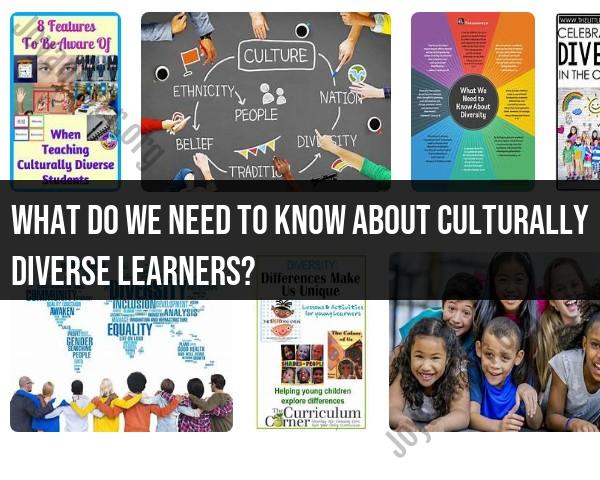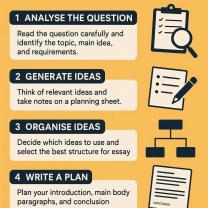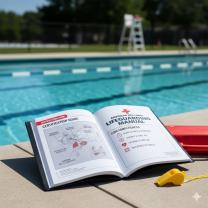What do we need to know about culturally diverse learners?
Educators and educational institutions need to be aware of and address the unique needs and considerations of culturally diverse learners to provide an inclusive and effective learning environment. Here are key considerations when working with culturally diverse learners:
Cultural Sensitivity:
- Educators should be culturally sensitive and aware of the cultural backgrounds, traditions, and beliefs of their students. Avoid stereotypes and biases.
Language Diversity:
- Language differences can be a significant barrier to learning. Recognize that students may come from diverse language backgrounds and proficiency levels. Provide language support when necessary, such as English as a Second Language (ESL) programs.
Cultural Competence:
- Teachers should strive to develop cultural competence, which includes an understanding of different cultures, traditions, and customs. This knowledge helps build trust and rapport with culturally diverse students.
Inclusive Curriculum:
- Ensure that the curriculum reflects diverse perspectives, cultures, and histories. Use inclusive teaching materials and resources that are representative of various cultures.
Culturally Relevant Teaching:
- Culturally relevant teaching acknowledges and respects the cultural experiences of students. It involves using teaching methods that connect with students' backgrounds and experiences.
Support for Trauma and Displacement:
- Many culturally diverse learners may have experienced trauma or displacement due to factors like war, conflict, or immigration. Schools should provide support services and a safe environment for these students.
Religious and Dietary Considerations:
- Be aware of students' religious practices and dietary restrictions. Accommodate these considerations, especially during school events, exams, and meal options.
Parental and Community Involvement:
- Encourage parental and community involvement in the educational process. These stakeholders can provide valuable insights and support for culturally diverse students.
Individualized Learning Plans:
- Recognize that students have individual learning needs. Develop Individualized Education Plans (IEPs) or accommodations to support students with diverse learning styles and needs.
Cultural Awareness Training:
- Provide cultural awareness and diversity training for teachers, staff, and students to foster an inclusive and respectful school environment.
Anti-Bullying and Inclusion Programs:
- Implement anti-bullying and inclusion programs to create a welcoming and safe school climate for all students, regardless of their cultural backgrounds.
Mental Health and Counseling Services:
- Offer mental health and counseling services to help culturally diverse students cope with the challenges they may face, including acculturation stress and discrimination.
Celebrating Diversity:
- Celebrate cultural diversity through events, cultural festivals, and activities that promote understanding and appreciation of different backgrounds.
Language Access Services:
- Provide language access services for parents and guardians who may have limited proficiency in the language of instruction. This can include translated materials and interpreters.
Feedback and Open Communication:
- Foster open and respectful communication between educators, students, and families. Encourage feedback and discussions to address concerns and challenges.
By considering these factors and actively working to create an inclusive and culturally sensitive learning environment, educators can better support the educational needs of culturally diverse learners, promoting their academic success and well-being.
Understanding Culturally Diverse Learners: Key Considerations
Culturally diverse learners are students who come from different backgrounds, including different races, ethnicities, religions, socioeconomic statuses, and abilities. Each student brings their own unique experiences, perspectives, and values to the classroom.
It is important for educators to understand the unique needs of culturally diverse learners in order to create a supportive and inclusive learning environment. Here are some key considerations:
- Cultural identity: Students' cultural identities are shaped by their experiences, values, and beliefs. Educators should respect and affirm students' cultural identities in the classroom.
- Learning styles: Students may have different learning styles based on their culture. Educators should use a variety of teaching methods and strategies to accommodate all learners.
- Communication: Students may have different communication styles based on their culture. Educators should be sensitive to these differences and create a classroom environment where all students feel comfortable communicating their ideas.
- Home-school connection: Families play an important role in their children's education. Educators should partner with families to support student learning at home and in the classroom.
Cultural Competence in Education: What Educators Should Know
Cultural competence in education is the ability to understand and respond to the needs of culturally diverse learners. Culturally competent educators are able to:
- Recognize and appreciate their own cultural biases. All people have cultural biases, but it is important for educators to be aware of their own biases so that they can avoid letting them influence their interactions with students and their teaching practices.
- Learn about the cultures of their students. Educators should make an effort to learn about the cultures of their students by reading books and articles, talking to families, and observing students' interactions with each other.
- Create inclusive learning environments. Educators should create classroom environments where all students feel welcome and respected. This includes using culturally responsive curriculum and materials, and promoting respectful and inclusive language and behavior.
- Adapt their teaching practices to meet the needs of all learners. Educators should use a variety of teaching methods and strategies to accommodate all learners, regardless of their cultural background.
Cultural Sensitivity in the Classroom: A Guide for Teachers
Cultural sensitivity in the classroom is the ability to be aware of and responsive to the cultural differences of students. Culturally sensitive teachers are able to:
- Avoid making assumptions about students based on their cultural background. It is important to remember that generalizations about entire groups of people can be dangerous and inaccurate.
- Be respectful of students' cultural values and beliefs. Educators should be mindful of the cultural values and beliefs of their students, and avoid promoting their own values and beliefs as the only correct ones.
- Use inclusive language and behavior. Educators should use language and behavior that is inclusive of all students, regardless of their cultural background. This includes avoiding stereotypes and generalizations, and using respectful pronouns.
Celebrating Diversity: Promoting Inclusivity in Education
Celebrating diversity in education is important because it helps students to develop a sense of belonging and respect for others. Inclusive schools provide all students with the opportunity to succeed, regardless of their cultural background.
Here are some ways to promote inclusivity in education:
- Teach students about different cultures. Educators can teach students about different cultures through social studies lessons, literature, art, and music.
- Encourage students to share their own cultures with the class. Students can share their cultures with the class through presentations, activities, and food.
- Create a classroom environment where all students feel safe and respected. Educators should create a classroom environment where all students feel safe and respected, regardless of their cultural background. This includes promoting diversity awareness and tolerance, and addressing bullying and discrimination.
Culturally Responsive Teaching: Strategies for Success
Culturally responsive teaching is an approach to teaching that acknowledges and values the cultural backgrounds of all students. Culturally responsive teachers are able to:
- Use culturally relevant examples and materials in their teaching. Educators can use culturally relevant examples and materials to make their teaching more relevant and engaging for all students.
- Connect students' prior knowledge and experiences to their learning. Educators can connect students' prior knowledge and experiences to their learning by asking them questions about their backgrounds and cultures.
- Provide opportunities for students to learn about different cultures. Educators can provide opportunities for students to learn about different cultures through social studies lessons, literature, art, and music.
- Empower students to share their own cultures with the class. Educators can empower students to share their own cultures with the class through presentations, activities, and food.
By following these strategies, educators can create a more culturally responsive and inclusive learning environment for all students.













